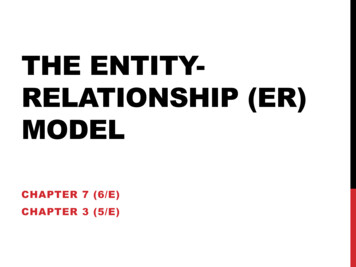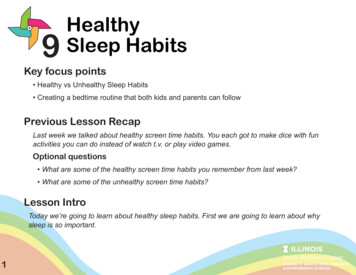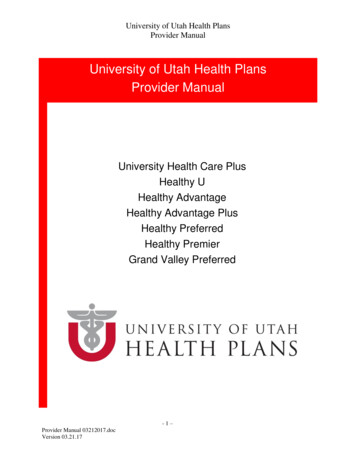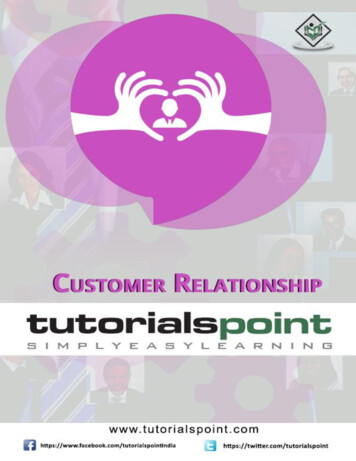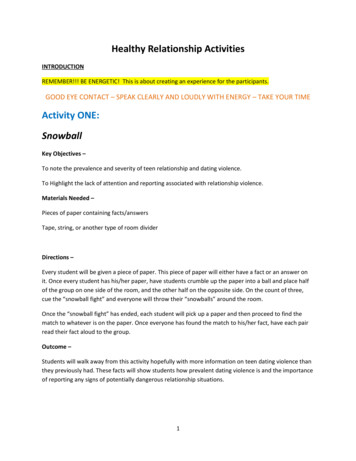
Transcription
Healthy Relationship ActivitiesINTRODUCTIONREMEMBER!!! BE ENERGETIC! This is about creating an experience for the participants.GOOD EYE CONTACT – SPEAK CLEARLY AND LOUDLY WITH ENERGY – TAKE YOUR TIMEActivity ONE:SnowballKey Objectives –To note the prevalence and severity of teen relationship and dating violence.To Highlight the lack of attention and reporting associated with relationship violence.Materials Needed –Pieces of paper containing facts/answersTape, string, or another type of room dividerDirections –Every student will be given a piece of paper. This piece of paper will either have a fact or an answer onit. Once every student has his/her paper, have students crumble up the paper into a ball and place halfof the group on one side of the room, and the other half on the opposite side. On the count of three,cue the “snowball fight” and everyone will throw their “snowballs” around the room.Once the “snowball fight” has ended, each student will pick up a paper and then proceed to find thematch to whatever is on the paper. Once everyone has found the match to his/her fact, have each pairread their fact aloud to the group.Outcome –Students will walk away from this activity hopefully with more information on teen dating violence thanthey previously had. These facts will show students how prevalent dating violence is and the importanceof reporting any signs of potentially dangerous relationship situations.1
Facts1.Teen Dating Violence is the physical, sexual, or psychological/emotional violencewithin a dating relationship2.Nearly 1.5 million high school students nationwide experience abuse from a partnerin a single year3.1 in 3 adolescents in the U.S. is a victim of physical, sexual, emotional or verbalabuse from a dating partner4.Only 33% of teens who were in a violence relationship ever told anyone about theabuse5.New Hampshire is the only state with a law that specifically allows minors to applyfor a protection order6.8 states do not include dating relationships in their definition of domestic violence,leaving young victims of abuse unable to apply for restraining orders7.81% of parents believe teen dating violence is not an issue or admit they don’t knowif it’s an issue8.Violent relationships put victims at higher risk for substance abuse, eatingdisorders, risky sexual behavior, and domestic violence9.Violent behavior in youth typically begins between ages 12 and 1810. An abused teen’s barriers to seeking help are confusion about the law and his orher desire for confidentiality11. 20 per 1,000 women ages 16-24 experience the highest per capita rate of intimateviolence12. One in three teens say they are text messaged 10, 20, or 30 times and hour by apartner inquiring where they are, what they’re doing, or who they’re with13. Percentage of eighth and ninth graders who are “dating” 72%14. Only one juvenile domestic violence court in the country focuses exclusively on teendating violence15. Female abuse victims are at greater risk of pregnancy and STIs16. Alcohol and drugs can influence violent behavior in relationships17. 24 people per minute are victims of rape, physical violence, or stalking by anintimate partner2
Activity TWO:Boundaries/ Crossing the LineKey Objectives –To highlight the importance of establishing boundaries within a romantic relationship.Materials Needed –Tape line on the ground to stand onSituational promptsDirections –Line up all participants along the line that you have placed on the floor. Once everyone has taken his/herplace on the line, read the first prompt. If a person is comfortable with the situation on the prompthe/she will take a step forward from the line. If uncomfortable, he/she will take a step behind the line. Itis not an option to remain on the line during any of the prompts. Once everyone has stepped forward orbackward from the line, ask participants to explain their reasons for taking the steps they did. Repeatthis process with other prompts.Outcomes –Students will come out of this activity having thought about how different scenarios and situationswould make them feel within their own romantic relationships. Students will see the importance ofestablishing physical and emotional boundaries in their relationships.Boundary Prompts Your partner gives you a kissYour partner pats you on the behindYour partner uses your car/phone/propertyYour partner calls you several time a dayYour partner likes knowing where you areYour partner sends you “sexts”Your partner takes you out to dinner/cooks dinner for youYour partner calls you by a certain nicknameYour partner buys you presentsYour partner tells you “I love you”Your partner makes comments about your outfitsYour partner goes out with you and your friends3
Activity THREE:Draw a Healthy RelationshipKey Objectives –To pay attention to the qualities and characteristics that make a healthy relationshipTo discuss differing opinions of good and bad relationship characteristicsMaterials Needed –MarkersPaper big enough to outline a bodyTape or something to hang paperDirections –Students will select one volunteer to come and trace a body on a large sheet of paper. Once the body istraced, place the paper on the wall. Students will then take turns coming writing or drawing positivetraits of potential partners or relationships on the body. If students have an idea of a negative characteror relationship trait, they will write or draw them around the outer border of the body. Once everyonehas had an opportunity to write on the body, discuss what was drawn or written.Outcomes –Students will learn about the qualities of a healthy relationship through participating in this activity.They will have the opportunity to discuss why certain traits can be considered positive or negative withtheir peers.4
Activity FOUR:True View Media AnalysisKey Objectives –To examine the role of the media in establishing current social norms regarding relationship behaviorTo analyze the impact these messages have on today’s youthMaterials Needed –Access to music videosTrue View Healthy Relationships score sheetDirections –Make sure every student has a True View Healthy Relationships scoring sheet. Watch the selected musicvideo and then have students score the video according to the sheet. Once everyone has scored thevideo, go over why students gave the scores they did. If necessary, watch the video again.Outcomes –Students will use this activity to see the effects that music videos and the media have on ourperceptions of relationships. After participating in this activity, students will have a more critical outlookon the music industry’s portrayal of relationships, healthy or unhealthy.5
Watch the selected music video and then have students score the video according to the sheet. Once everyone has scored the video, go over why students gave the scores they did. If necessary, watch the video again. Outcomes – Students will use this activity to see the effects that music

